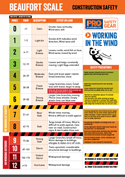POSTER: How to Brace Your Worksite for High Winds
Recently a Melbourne construction worker was killed when high winds brought an unfinished 4 metre brick wall down on top of him. The 30-year old father of two and his co-worker been working on the upper level of a partly constructed townhouse in East Brighton when the wind suddenly picked up, prompting the pair to climb down and work at the back of the construction site where they thought it would be safer.
Tragically, the actions they took to ensure their safety backfired as moments later a strong gust of wind brought a partially built garage wall down on top of them. Preliminary investigations suggest the storey high wall, which had been erected the week before, was not braced. If it was, this fatal accident may have been avoided.
Although strong winds can occur at any time year, they are certainly more frequent, and for the most part more severe during winter months. The wild weather that has swept Australia in recent weeks is evidence to that. To prevent unnecessary workplace injuries and tragedies, it is imperative that workers know the appropriate measures to take ensure their own safety, and that of their co-workers and bystanders around them.
Understanding the Hazards
Working at heights is especially risky in high winds as the lack of shelter exposes workers to stronger gusts that can throw workers off balance. At the same time the distance to the ground increases the likelihood that a fall will be fatal. (30% of fatal falls happen from a height of less than 2 metres, and 50% from less than 3 metres). Last month a New York construction worker was blown of the roof of an auto-dealership while installing metal decking. The 22-year old worker was wearing a fall protection harness but it wasn’t connected to an anchor point when a sudden gust of wind blew him off the edge, falling 24 feet to his death.
Working on the ground also presents many dangers. Unsupported structures can collapse as happened in Melbourne last month. High winds can pick up sparks from fires and blow tools, loose materials and debris around, endangering workers at lower levels as well as bystanders and nearby pedestrians. In 2011, a 3 year old Canadian girl was killed and her parents injured when a strong gust of wind blew a bundle of steel off the roof of a nearby construction site, striking the group as they walked down the street.
Following is a quick checklist you can reference to ensure your workplace and workers.
Always be Prepared
- Check weather reports and monitor conditions continuously. Do not schedule work at elevations on days where high winds are forecast
- Wind can pick up quickly and sudden gusts can take you by surprise. Hence, always wear a harness when working at heights over 1.5m. Verify you are connected to an anchor point at all times
- Ensure partially built structures are properly supported at all times regardless of weather conditions. Ensure walls are adequately braced until building is complete
- Confirm scaffolding and other temporary structures are secure and could not be blown over
During High Winds
- Never work on scaffoldings, roofs or other elevations during strong winds. (Winds in excess of 37km can affect balance)
- Ensure that tools are packed away safely. Confirm roofing sheets, cones, signage and other loose materials are safely secured. (A 32km per hour wind is classed on the beaufort scale as a ‘fresh breeze’. It can pick up a piece of scrap material and carry it as far out as the height from which it came.)
- Wear eye protection to keep dust, debris and other foreign particles from blowing into the eyes
- Ensure hard hats are securely fastened and cannot be blown off your head
- Use extreme caution when picking up large sections of plywood or similar flat materials, as these can act as a sail.
- Tag lines should be used when hoisting loads with large flat surfaces
- Do not operate hoisting equipment (personnel or material) in winds exceeding 55km/hr without approval from your supervisor. (Supervisors should consult manufacturers recommendations for guidance)
- Cease all crane operations until wind speed returns to acceptable levels
Beaufort Scale for Construction Workers
To help workers identify wind hazards and know appropriate actions to take, we designed a Beaufort Scale Construction Safety Guide.
Have we missed anything? Do you have any tips, stories or advice to share that could help workers prevent accidents when working in the wind? Please let us know in the comments below.









































































